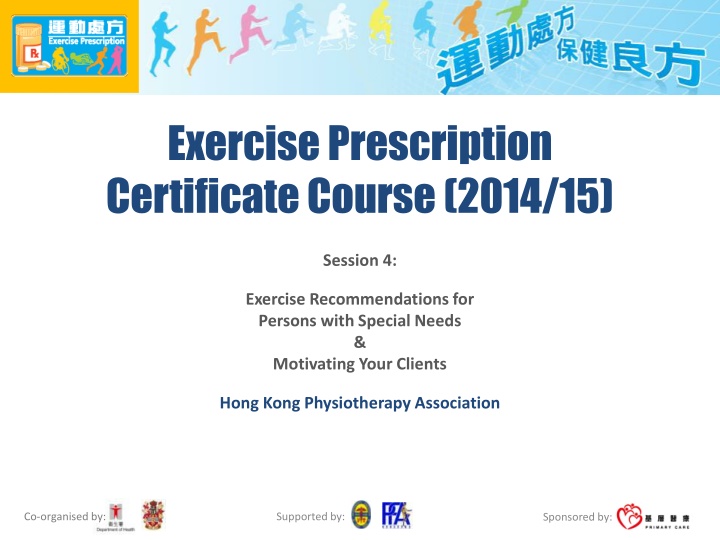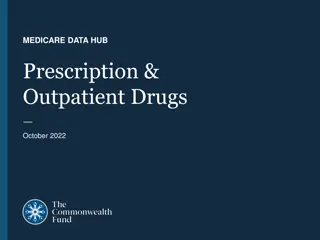Exercise Prescription Certificate Course 2014/15 Session 4: Exercise Recommendations for Persons with Special Needs & Motivating Your Clients
This course session focuses on prescribing exercise for individuals with specific health conditions such as diabetes mellitus, hypertension, heart disease, osteoarthritis, and osteoporosis. It also covers strategies to motivate clients to adopt and maintain an exercise regimen, prevent exercise-related injuries, and includes a clinical case study. Benefits of exercise for patients with diabetes mellitus are highlighted, emphasizing structured exercise interventions to improve insulin sensitivity. Additionally, the evaluation of diabetes mellitus patients before recommending an exercise program is discussed, emphasizing the importance of assessing contraindicating conditions.
Download Presentation

Please find below an Image/Link to download the presentation.
The content on the website is provided AS IS for your information and personal use only. It may not be sold, licensed, or shared on other websites without obtaining consent from the author.If you encounter any issues during the download, it is possible that the publisher has removed the file from their server.
You are allowed to download the files provided on this website for personal or commercial use, subject to the condition that they are used lawfully. All files are the property of their respective owners.
The content on the website is provided AS IS for your information and personal use only. It may not be sold, licensed, or shared on other websites without obtaining consent from the author.
E N D
Presentation Transcript
Exercise Prescription Certificate Course (2014/15) Session 4: Exercise Recommendations for Persons with Special Needs & Motivating Your Clients Hong Kong Physiotherapy Association Co-organised by: Supported by: Sponsored by:
2 Outline of this Session Prescribing Exercise to Patients with Diabetes Mellitus, Hypertension, Heart Disease, Osteoarthritis, Osteoporosis Motivating your clients: Improving Exercise Adoption and Maintenance Prevention of Exercise Related Injuries Exercise Practice Clinical Case Study Co-organised by: Supported by: Sponsored by:
Self-Study Doctor s Handbook: Chapters 4 11, 13 for further reading Co-organised by: Supported by: Sponsored by:
Prescribing Exercise to Patients with Diabetes Mellitus Co-organised by: Supported by: Sponsored by:
DM Patients Acute Response to Exercise Blood glucose utilisation by muscles usually rises more than hepatic glucose production blood glucose levels tend to decline risk of exercise-induced hypoglycemia for those taking insulin and/or insulin secretagogues if medication dose or carbohydrate consumption not altered * On the other hand, hypoglycemia rare in DM patients not treated with insulin or insulin secretagogues Co-organised by: Supported by: Sponsored by:
Benefits of Exercise for DM Patients Structured exercise interventions can lower A1C by 0.7% in people with T2 DM Progressive resistance exercise improves insulin sensitivity in older men with Type 2 DM to the same or even greater extent as aerobic exercise Co-organised by: Supported by: Sponsored by:
Evaluation of the DM Patient Before Recommending an Exercise Programme Assess patients for contraindicating conditions, e.g. uncontrolled hypertension severe autonomic neuropathy severe peripheral neuropathy history of foot lesions unstable proliferative retinopathy Co-organised by: Supported by: Sponsored by:
Exercise stress testing NOT routinely recommended to detect ischaemia in asymptomatic individuals at low coronary heart disease (CHD) risk (<10 % in 10 yrs) Advised primarily for sedentary adults with DM who are at higher risk for CHD and who would like to undertake activities more intense than brisk walking Some Risk Factors for CHD include: Age > 40, Concomitant risk factors such as hypertension, microalbuminuria, etc., Presence of advanced cardiovascular or microvascular complications (e.g. retinopathy, nephropathy) Co-organised by: Supported by: Sponsored by:
Recommendations for Prescribing Exercise to DM Patients Exercise prescription with the FITT principle More or less the same as that recommended for Healthy Adults Rate of progression should be gradual Co-organised by: Supported by: Sponsored by:
Recommendations for Prescribing Aerobic Exercise to Patients with DM Frequency: Perform moderate-intensity aerobic PA on 3 days/wk Intensity: At least at moderate intensity. Additional benefits may be gained from vigorous-intensity aerobic exercise Time: Perform 20-60min per day to a total of 150 min/wk Type: Exercise requires little skill to perform is preferable Evidence showed that walking is an excellent choice Co-organised by: Supported by: Sponsored by:
Recommendations for Prescribing Resistance Exercise to Patients with DM Frequency: Perform 2 nonconsecutive days/wk, ideally 3 times/week Intensity: An intensity between moderate and vigorous intensity (i.e. 50-80% of 1-RM) Time: Each target muscle group should be trained for a total of 3 sets with 8-10 reps/set Type: 8-10 resistance exercises working major muscle groups of the body E.g. Tubing / elastic band exercise Co-organised by: Supported by: Sponsored by:
Exercise in the Presence of Non-optimal Glycaemic Control Hyperglycaemia Vigorous activity should be avoided during ketosis T2DM patients generally do not have to postpone exercise simply because of high blood glucose as long as they feel well and are adequately hydrated Hypoglycaemia In individuals taking insulin and/or insulin secretagogues, PA can cause hypoglycaemia Added carbohydrate should be ingested if pre-exercise glucose levels are <5.6 mmol/l Around 20-30g carbohydrate, i.e. 1 slice of bread Co-organised by: Supported by: Sponsored by:
Exercise in the Presence of Specific Long-term DM Complications Retinopathy vigorous aerobic or resistance exercise may be contraindicated in proliferative / severe non-proliferative DM retinopathy Peripheral neuropathy Individuals with peripheral neuropathy and without ulcer may participate in moderate weight-bearing exercise Comprehensive foot care recommended for prevention and early detection of ulcers Anyone with an open ulcer should confine themselves to non-weight-bearing activities Co-organised by: Supported by: Sponsored by:
Exercise in the Presence of Specific Long-term DM Complications Autonomic neuropathy Associated with decreased cardiac responsiveness to exercise, postural hypotension, impaired thermoregulation, and hypoglycaemia due to impaired gastroparesis Should receive physician approval and possibly an exercise stress test before more intense PA Uncomplicated albuminuria and nephropathy (i.e. without electrolyte imbalance or uraemia) No PA contraindications unless with potential complications Co-organised by: Supported by: Sponsored by:
Special Precautions Preferable exercise at the same time of a day Encourage patients to exercise with partners Bring along some fast and easy to digest sugars (high glycaemic index) Intermittent exercise (i.e. more frequent rest) is more desirable than a prolonged session of continuous exercise Co-organised by: Supported by: Sponsored by:
Special Precautions Encourage patients with Type 2 DM to monitor their blood glucose level before and after exercise session, especially when beginning an exercise programme Encourage patients to keep log with the exercise intensity, duration and type for monitoring their glucose response to the exercise Pay attention to proper foot wear (wear shoes that cover both the toes and heels and wear socks to keep the feet dry and prevent blisters) Co-organised by: Supported by: Sponsored by:
Further Reading Hong Kong Reference Framework for Diabetes Care for Adults in Primary Care Settings http://www.pco.gov.hk/englis h/resource/professionals_dia betes_pdf.html Co-organised by: Supported by: Sponsored by:
Prescribing Exercise to Patients with Hypertension Co-organised by: Supported by: Sponsored by:
HT Patients Acute Response to Exercise During Aerobic Exercise: Absolute level of SBP attained is usually higher The slope of the pressor response is either exaggerated or diminished DBP typically stays constant or is slightly, rarely does the DBP decrease Arise in DBP is likely the result of an impaired vasodilatory response Co-organised by: Supported by: Sponsored by:
HT Patients Acute Response to Exercise Immediately After Aerobic Exercise Post-exercise hypotension: most studies in hypertensive subjects demonstrated significant post-exercise ambulatory BP E.g. a 10-20 mm Hg SBP during the initial 1-3 hrs post-exercise May persist up to 22hours after exercise Co-organised by: Supported by: Sponsored by:
HT Patients Acute Response to Exercise During Resistance Exercise Heavy-resistance exercise in particular elicits a pressor response causing only moderate heart rate and cardiac output increases SBP/DBP can increase dramatically more than that seen in aerobic exercise Co-organised by: Supported by: Sponsored by:
HT Patients Acute Response to Exercise Immediately After Resistance Exercise Post-exercise hypotension: but its magnitude, duration, and mechanism of action need to be more thoroughly investigated low-intensity resistance exercise seems to have stronger hypotensive effects and subjects with higher blood pressures seem to experience greater blood pressure reductions after resistance exercise Co-organised by: Supported by: Sponsored by:
Long Term Effects of Exercise Aerobic training reduces resting BP in the hypertensive individual: SBP: 6.9 mmHg DBP: 4.9 mmHg Resistance Exercise also reduces resting BP by: SBP: 3.5 mmHg DBP: 3.2 mmHg Co-organised by: Supported by: Sponsored by:
Evaluation of the HT Patient Before Recommending an Exercise Programme Hx taking, PE and Ix Risk of CHD events largely determined by: level of blood pressure, presence or absence of target organ damage, other risk factors Smoking dyslipidaemia Diabetes, etc Co-organised by: Supported by: Sponsored by:
Recommendations for Prescribing Aerobic Exercise to Patients with Hypertension Frequency: Perform moderate-intensity aerobic PA preferably all days of the week Intensity: At least at moderate intensity Time: Perform a total of 30 min/per day Type: Exercise requires little skill to perform is preferable Aquatic exercise as an excellent choice Progression: Gradual Co-organised by: Supported by: Sponsored by:
Recommendations for Prescribing Resistance Exercise to Patients with Hypertension Frequency: Perform 2 nonconsecutive days/wk, ideally 3 times/week Intensity: at moderate intensity (i.e. 50-70% of 1-RM) Time: Each target muscle group should be trained for a total of 1 set with 8-12 reps/set Type: 8-10 resistance exercises working major muscle groups of the body Progression: Slow : starts with lower intensity and higher rep in order to minimize the rise of BP Co-organised by: Supported by: Sponsored by:
Special Precautions Adopt slow and constant movement speed Avoid breath holding (Valsava Manuver) Intensive isometric exercise such as heavy weight lifting can have a marked pressor effect and should be avoided Heavy physical exercise should be discouraged or postponed in poorly controlled HT No exercise training should be started at SBP > 200mmHg and/or DBP > 110mmHg Best to maintain SBP at 220 mmHg and/or DBP 105 mmHg mmHg Co-organised by: Supported by: Sponsored by:
Special Precautions -blockers and diuretics may adversely affect thermoregulatory function and cause hypoglycaemia educate patients on sign & symptoms of heat intolerance and hypoglycaemia, and the corresponding precautions Antihypertensive medications such as Calcium Channel Blocker, -blockers and vasodilators may lead to sudden reductions in post-exercise BP. Extend and monitor both WARM-UP and COOL-DOWN period carefully Clinically, symptoms like SOB, premature-fatigue, are commonly seen in HT patients with inadequate warm up Co-organised by: Supported by: Sponsored by:
Special Precautions -blockers may reduce sub-maximal and maximal exercise capacity Using perceived exertion to monitor exercise intensity Patients should be informed about cardiac prodromal symptoms: shortness of breath, dizziness, chest discomfort or palpitation Co-organised by: Supported by: Sponsored by:
Further Reading Hong Kong Reference Framework for Hypertension Care for Adults in Primary Care Settings http://www.pco.gov.hk/engli sh/resource/professionals_hy pertension_pdf.html Co-organised by: Supported by: Sponsored by:
Prescribing Exercise to Patients with Heart Disease Co-organised by: Supported by: Sponsored by:
Exercise-related Sudden Death in Patient with Cardiac Diseases CHD accounts for most exercise-related sudden deaths among those aged 35 years or above A considerable number of fatal MIs were not due to significant stenosis of the coronary arteries but rupture of unstable coronary atherosclerotic plaque possibly during exercise Co-organised by: Supported by: Sponsored by:
Long Term Effects of Exercise- IHD Exercise can improve health outcomes in patients with stable IHD: Slower disease progression Significantly fewer ischaemic events Reduce concomitant atherosclerotic risk factors such as hypertension, hyperlipidaemia, hyperglycaemia, obesity and tobacco use Exercise-only cardiac rehabilitation reduce total cardiac mortality and all-cause mortality by 31% and 27% respectively Co-organised by: Supported by: Sponsored by:
Long Term Effects of Exercise- CHF Improved physical capacity (an increase of 10 to 30% of the maximum physical capacity) Improved quality of life Improved endothelial function Reduced serum catecholamine levels Reduced morbidity and hospital re-admission rates Possible reduction of all-cause mortality Possible improvement of resting cardiac function Co-organised by: Supported by: Sponsored by:
Pre-participation Evaluation All patients with heart disease should have their clinical status carefully reviewed by relevant specialists before heading for an exercise programme A physical exercise testing is often necessary to identify any potentially dangerous electrocardiographic abnormalities and to stratify risks in patients with heart disease Co-organised by: Supported by: Sponsored by:
Pre-participation Evaluation Possible Investigations: Resting ECG, Holter ECG monitoring, Echo, Physical exercise test (using treadmill or bicycle), Physical or pharmacological stress test with single PECT, Maximal physical or pharmacological stress with Echo or MRI, or Coronary angiography Aims to find out: Ischaemia, arrhythmias, structural abnormalities e.g. cardiac hypertrophy, regional wall motion abnormalities, ventricular dysfunction, perfusion defects, coronary flow disturbances or abnormal coronary anatomy Co-organised by: Supported by: Sponsored by:
Recommendations for Exercise Prescription Exercise prescribed according to FITT principle FITT of the Exercise prescribed should be tailored to each individual in accordance with Underlying pathology of the heart disease their physical condition aerobic/anaerobic fitness AND local muscular condition PA should be linked to other lifestyle modifications to minimise cardiac risk Co-organised by: Supported by: Sponsored by:
Good Practices for Cardiac Patients Undertaking Physical Activity No exercise should be started in unstable cardiac patients e.g. cardiac tamponade, acute pulmonary edema, etc No exercise in case of unusual asthenia, fever or viral syndrome Adapt the intensity of PA to the environmental conditions, temperature, humidity and altitude Include three periods in each physical activity session: warm-up, training and cool-down Proper warm-up and cool-down phases may have an anti-anginal and possibly cardioprotective effect Advise low-impact aerobic activity to minimise risk of musculoskeletal injury Co-organised by: Supported by: Sponsored by:
Good Practices for Cardiac Patients Undertaking Physical Activity The level of supervision and monitoring during exercise depends on the result of risk stratification from patient assessments and clinical evaluations Recommend gradual increases in dosage of PA over time Terminate exercise immediately if warning signs or symptoms occur Avoid smoking at all times Hot shower, which may result in an increased heart rate and arrhythmias, should be avoided during the 15 mins after PA Co-organised by: Supported by: Sponsored by:
Special Precautions Patients with Ischemic Heart Disease PA contraindicated for patients with unstable angina Avoid competitive sports Patients with Congestive Heart Failure PA contraindicated in case of new onset AF and obstructive valvular heart disease Aquatic exercise is generally safe to CHF patients and could be used to improve exercise capacity But it may not be suitable for all CHF patients because head-up immersion and the hydrostatically-induced volume shift MAY result in LV volume loading, with of heart volume and pulmonary capillary wedge pressure Co-organised by: Supported by: Sponsored by:
Special Precautions Patients with pacemakers Can participate only in exercise consistent with the limitation of the underlying heart disease Avoid Ex with risk of bodily impact/pronounced arm movements Valvular heart disease patients Physical check-ups and exercise testing should be conducted Co-organised by: Supported by: Sponsored by:
As a Responsible GP Should advocate exercise by prescribing exercise after investigation and thorough assessment OR Referring the patients to specialist consultation or cardiac rehabilitation program Teach patients with heart disease to monitor their S/S for medical emergency Know the contraindications to exercise training e.g. unstable angina , decompensated HF Co-organised by: Supported by: Sponsored by:
Prescribing Exercise to Overweight and Obese Patients Co-organised by: Supported by: Sponsored by:
Obese Peoples Acute Response to Exercise little impact on being overweight/obese Exercise can have deleterious effects on the obese person who overdoes a single exercise routine Excessive load on weight-bearing joints and spine Impaired thermoregulation in hot environmental conditions Mental distress and physical discomfort Co-organised by: Supported by: Sponsored by:
Long Term Effects of Exercise PA (45mins 3 times/wk) + diet (600 kcal/deficit or low fat) results in an approximate weight of 1.95 kg (range = 1.0-3.6kg) compared to diet alone at 12 months Yet PA appeared to be less effective than diet as a sole weight loss intervention Co-organised by: Supported by: Sponsored by:
Weight Management Weight Management should be emphasized as a long term goal need to produce a negative energy balance by decreasing energy intake from diet and increasing energy expenditure from exercise target of weight reduction should be limited to 1 kg / wk (i.e. energy deficit of 7700kcal/wk) Dieting alone may lower metabolic rate which in long run may increase body weight Co-organised by: Supported by: Sponsored by:
Recommendations for Prescribing Aerobic Exercise to Overweight and Obese Patients Frequency: 5 days/wk Intensity: Moderate- to vigorous-intensity Time: 45-60 min/day of moderate-intensity aerobic activity To avoid regaining of weight: 60-90 min/day of activity Type: Exercise requires little skill to perform is preferable Aquatic and walking exercises are excellent choices Progression: starts with long duration (with intermittent resting) and lower intensity exercise Co-organised by: Supported by: Sponsored by:
Special Considerations on Ex Prescription Presence of other comorbidities (e.g. dyslipidaemia, HT, DM, etc.) may increase risk stratification Aerobic exercise as major supplemented with resistance exercise (as minor) Prescription of higher PA targets (i.e. 300 mins per week of moderate-intensity PA) only resulted in significantly greater weight loss when : inclusion of family members in programme small group meetings with exercise coaches OR small monetary incentives Co-organised by: Supported by: Sponsored by:
Special Considerations on Ex Prescription Vigorous exercise is probably not appropriate for the very obese (BMI > approximately 35 kg/m2) Presence of musculoskeletal conditions and limitations of exercise capacity may require modifications to exercise Weight-bearing PA may be difficult for some individuals with BMI > approximately 35 kg/m2, particularly for those with joint problems gradually increasing non-weightbearing PA (e.g. cycling, swimming, water aerobics, etc.) should be encouraged Co-organised by: Supported by: Sponsored by:
Special Considerations Modify lifestyles with the use of behavioral modifications skills Lifestyle PA is recommended, e.g. E.g. playing with children, mopping the floor, climbing up stairs at train stations, etc. Co-organised by: Supported by: Sponsored by:























